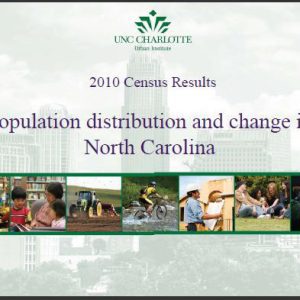Maps

A summary presentation of population trends related to North Carolina. Based on Census 2010 preliminary (redistricting) data released in the spring of 2011. To see a PDF of the presentation: Download PDF Read the related article on this site.

An examination of the Census 2010 data released so far provides several insights into how North Carolina’s growth compared to other states. North Carolina was the 6th fastest-growing state in the 2000s at 18.5%, putting it just between Texas and Georgia, and virtually tied with Georgia in growth since the 1990s. That level of growth […]

The recently released South Carolina data from US Census 2010 now allow for a more complete picture of growth in the Charlotte Region in the last decade. The South Carolina counties of Chester, Lancaster and York form the southern flank of the 14-county Charlotte Region. The census data show York County was the second-fastest growing […]

Last week, the Appellate Court for the District of Columbia ruled against Alcoa’s petition requesting that the Federal Energy Regulatory Commission (FERC) proceed with issuing the company a new license to continue operating its dams along the Yadkin River. This ruling was not the final determination concerning who will own and operate Alcoa’s dams and […]

Controversies over school closures in Charlotte and Mecklenburg County over the past year have refocused public attention on issues of race in our community. While the explosive growth of the Hispanic population has been a more recent demographic trend, the issue of residential segregation among blacks and whites has a much longer history in this […]

On Wednesday, March 2nd, the first set of data from the 2010 Census was released for North Carolina counties, cities, towns, etc., providing the first hard population counts for these areas since 2000. We know that the Charlotte region as a whole has grown rapidly in the last decade, but how has that growth been […]

The map below shows the percent change in population for cities from 2000 to 2010 – the larger the circle, the higher the percent change. Click on individual cities to see additional population data. You may pan and zoom the map to see greater detail. If you have trouble selecting an individual city, you may […]

Today’s public libraries are expected to deliver traditional services in a rapidly changing technological environment . As libraries struggle to maintain high quality programs that are financially sustainable, the impact of the recent recession and the consequent decline in financial support further challenges libraries to find ways to survive while continuing to deliver essential services. […]

In the early 1950s the not yet established Research Triangle Park (RTP) was pitched to Governor Luther Hodges as a cluster of “two medical schools, two engineering schools and a core of preeminent researchers in every field of science.” Hodges response: he called the presenter (a dean at NC State College) a “huckster.”[i] North Carolinians […]

After boasting one of the nation’s most successful mandatory busing plans to desegregate the district’s schools, Charlotte-Mecklenburg Schools (CMS) has once again become increasingly segregated. This shift has been documented meticulously through numerous recent studies and disseminated to the public through coverage in the local media. In partnership with Council for Children’s Rights, as part […]

High rates of obesity and diabetes have spurred research to understand the causes and to identify prevention strategies. Evaluation of the neighborhood environment as it relates to food access is a growing area of research. Many studies have found that residents in low income and minority communities have poor access to grocery stores and healthy […]

From 1976 to 2006, land development in the North Carolina mountains increased 568 percent – from 34,348 acres to 229,422 acres – and is expected to increase another 63 percent by 2030. Population, meanwhile, increased only 42 percent between 1976 and 2006 and is projected to increase only another 25 percent by 2030. The result? […]